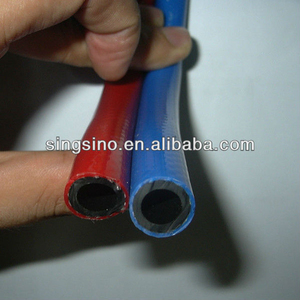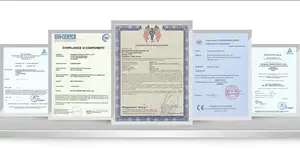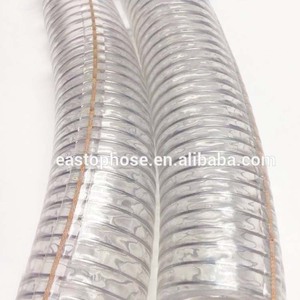(369 products available)






























































































































































































A 9mm gas hose is a flexible tube used to connect gas appliances to a gas source. It comes in different materials, each with unique features and applications. Here are the common types:
Rubber Gas Hoses
Rubber gas hoses are small-diameter gas pipes made of synthetic or natural rubber. They are common due to their flexibility, lightweight, and affordability. Typically, they are reinforced with nylon threads to improve strength and durability. Also, they have a weather-resistant cover that protects them from external elements. These gas hoses are used in outdoor and indoor applications. They can be used with various gases, such as butane, propane, and natural gas. However, they have a limited lifespan due to exposure to UV rays and ozone. They are not the best option for long-term applications.
PVC Gas Hoses
PVC gas hoses are produced from polyvinyl chloride. They are lighter and have a smoother inner surface than rubber gas hoses. They are popular for their resistance to abrasion and ozone. These gas hoses are mostly used in outdoor applications. They are resistant to UV radiation and weather elements. PVC gas hoses are mostly used with low-pressure gas applications. They are not as popular as rubber gas hoses since they offer less flexibility. Additionally, they can become brittle when exposed to extreme temperatures.
Stainless Steel Gas Hoses
These hoses are constructed from braided stainless steel. They offer a modern and sleek look and are highly durable. This gas hose is popular for its excellent corrosion resistance and minimal gas permeability. They are mostly used in high-pressure applications. Stainless steel gas hoses are ideal for applications requiring high temperatures and pressures. They include water heaters and stoves. Stainless steel gas hoses are reusable. Their design makes them resistant to kinks and abrasions. Nonetheless, they offer less flexibility compared to rubber gas hoses. Also, they can be more expensive.
Coiled Gas Hoses
Coiled gas hoses are made of rubber. They have a coiled design that resembles a spring. The design enables them to be compact when not in use. These gas hoses are popular for outdoor applications. They are resistant to UV rays, kinking, and abrasion. Coiled gas hoses are ideal for low-pressure applications. They can be used with portable gas appliances. Also, they are designed to reduce gas flow disruption and improve convenience when used with gas appliances.
Gas Flow
Gas hoses transfer gas from the cylinder to the appliance. The gas flows through the hose because of pressure differences between the cylinder and the appliance. The gas travels from high pressure in the cylinder to lower pressure in the appliance for cooking.
Flexibility
9mm gas hoses are flexible. This means they can bend easily without breaking. Their flexibility allows the hose to be routed around obstacles while keeping a safe connection. The flexible hose reduces tension and strain points that could cause leaks.
Pressure Resistance
These hoses are made to withstand high pressures without bursting. Gas hoses are used in low-pressure applications like BBQs and portable cookers. They are also used in higher-pressure applications like gas cylinders for outdoor heaters and gas foray lighting.
Durability
The 9mm gas hose is weatherproof and resistant to UV rays. This prevents degradation over time from sunlight exposure. The hoses can also endure abrasions from being knocked or dragged across surfaces. Their durability gives the hose a longer lifespan before it needs replacement.
Compatibility
These hoses connect gas cylinders to appliances used in outdoor cooking and heating. The 9mm gas hose is compatible with various gas appliances. Always check the manufacturer recommendations for the correct gas hose size and type for each appliance.
Safety
Safety is a key feature of the 9mm gas hose. It has built-in safety features. Most hoses have flame-resistant materials that won't catch fire easily if exposed to high-temperature flames. This reduces the risk of the hose igniting from sparks or heat.
Leak Detection
Many gas hoses come with leak detection features. They may have indicators that show the user if there is a gas leak. Some hoses also have quick-disconnect fittings that make it easy to detach the hose when not in use. This prevents accidental disconnection that could cause leaks.
A 9mm gas hose can be used in various applications. Here are some of them:
Consider the application
Applications or uses for gas hoses differ. Some are for links in static places, while others are for flexible connections in moving appliances. Static applications are for gas hoses used in places that are not moved or changed, while flexible connections are for those used in appliances and equipment that can be moved around.
Check the pressure rating
Pressure ratings show how much pressure a hose can handle safely. It is important to choose a hose with a pressure rating higher than the appliance's gas pressure. This ensures safety and prevents accidents.
Look at the temperature rating
Temperature ratings show the highest and lowest temperatures a hose can handle. It is important to choose a hose with a temperature rating suitable for the environment and the gas's temperatures.
Check for certifications and standards
Various organizations set the standards that gas hoses must meet. It is important to check and see if the hose has met these standards and received certification. This ensures that the hose is of good quality and safe to use.
Evaluate the materials
Gas hoses are made from different materials. The materials used to make the hoses determine their flexibility, durability, and resistance to various environmental factors.
Length and diameter
The length and diameter of the hose affect the gas flow. A longer hose has reduced pressure, while a wider diameter increases flow rate. It is important to balance the hose length and diameter to ensure optimal performance.
Check compatibility
Ensure that the gas hose is compatible with the type of gas used. Most common gases are LPG and natural gas.
Q1. What is the gas fitting on a BBQ?
A1. The BBQ gas fitting is known as the gas coupling. It is a male fitting that connects to the hose's female fitting to create a gas-tight connection.
Q2. How long can a gas hose be?
A2. The gas hose can be as long as 25m. However, this distance will depend on the gas source's pressure. A long hose results in low pressure, while a short hose maintains the pressure. A long 9mm gas hose may not be ideal for high-pressure gas applications.
Q3. How often should gas hoses be replaced?
A3. Gas hoses should be replaced every 5 years. However, this depends on the type of gas hose. Some gas hoses, like those for barbecues, should be replaced once they show signs of damage or discoloration. Always consult the manufacturer's manual for guidance.